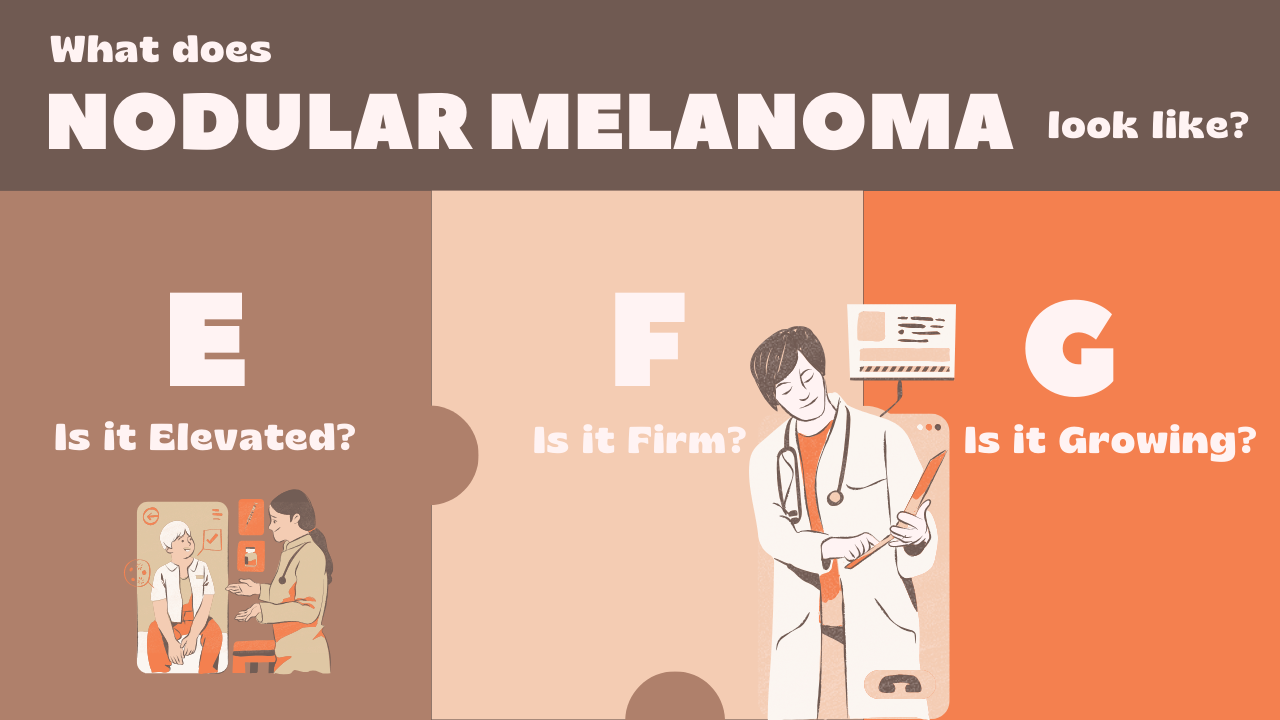Nodular melanoma is an invasive and aggressive form of skin cancer that originates from melanocytes, the cells responsible for providing pigment to the skin for its color. It accounts for 10-15% of diagnosed melanomas in Australia. Unlike other melanomas, nodular melanomas grow quickly beneath the skin’s surface, making them harder to detect. They are generally symmetrical, evenly colored, or even skin-colored, lacking pigment entirely. Nodular melanomas contribute significantly to the melanoma mortality rate due to their rapid growth and thickness at diagnosis. The survival rate is about 98% if it hasn’t spread at diagnosis, but it drops to 22% after 5 years if it has metastasized to other parts of the body.
Table of Contents
What does it look like?


Symptoms of Nodular Melanoma
The following changes to your skin should raise a red flag for nodular melanoma:
- It typically starts with a symmetrical dome shaped lump.
- It can occasionally be mistaken for an insect bite, a blood blister, or acne.
- One third of the lumps or bumps are skin-colored, but the rest can be black, pink, or red. Typically, it has a single, evenly pigmented tint.
- They are typically bigger than other body moles.
- Touching a nodular melanoma feels firm.
- The surface of the lesion may be smooth or rough and crusty.
- After a few months, they are likely to itch, sting, ulcerate, or bleed.
Treatment of Nodular Melanoma
Surgically removing the nodule and some of the surrounding healthy skin is the usual course of action for treating this condition. In order to determine whether any cancer cells have moved to your lymph nodes, a doctor could also advise a lymph node biopsy.
It takes further treatment to completely kill the cancer cells in melanoma that has spread to internal organs or lymph nodes. This might comprise:
- Immunotherapy – Drugs are used in immunotherapy to enhance your immune system’s capacity to detect and eliminate cancer cells. The most often prescribed immunotherapy medications for melanoma are checkpoint inhibitors. These medications function by activating T cells, immune cells that hunt down and destroy tumours.
- Targeted therapy – Utilizing medications that may specifically target and kill cells with particular DNA abnormalities is known as targeted treatment. This may prevent or impede the growth of malignant tumours. Targeted therapy is frequently combined with other forms of medicine, including immunotherapy.
- Radiation therapy – In order to eradicate cancer cells in particular regions of your body, radiation treatment uses concentrated radiation beams. After surgery, it’s frequently done to make sure all cancer cells have been eliminated and lower the chance of melanoma coming back.
- Chemotherapy – Chemotherapy isn’t used as frequently as it previously was but, in some circumstances, it still represents the best option.
In order to choose your therapy in the best possible way, it’s crucial to discuss the adverse effects of these procedures with your doctor. You can read more about treatments here.
How fast does nodular melanoma progress?
It can grow internally in as little as three months before developing into an advanced stage. In comparison to previous stages of the disease, advanced nodular melanoma is more challenging to cure.
How to identify nodular melanoma?
Remember ‘EFG’ – for elevated, firm and growing progressively for more than a month.
Elevated – Is it raised?
Firm – Is it firm to touch?
Growing – Is it growing quickly?
These can be warning signs to look for in moles and skin growth increasing the possibility of early detection.
Is nodular melanoma painful?
Skin cancers, particularly nodular melanoma, are rarely painful. Therefore, a concerned spot or mole may still be carcinoma even if it has not caused you any physical pain.
Where are they found?
The head, trunk, and neck of the body are a few common body parts or growth places where nodular melanoma can be seen. It often begins or spreads as a new growth rather than within an already-existing mole.
How common is nodular melanoma?
Melanoma of the skin is the third most common type of cancer in Australia. It can be deadly, accounting for nearly 3% of cancer deaths. Nodular melanomas comprise 10-15% of melanomas diagnosed in Australia.
What are risk factors for nodular melanoma?
A personal or family history of melanoma, frequent sun exposure, sunburn and the use of tanning beds, Dysplastic nevi (or atypical mole) or having large number of moles.
What is average size of nodular melanoma?
If the lesion present on the skin is larger than 6 to 7 millimeters in diameter or if it is still growing, it can be a case of melanoma, which can be cancerous.
Despite not being the most frequent form of melanoma in Australia, nodular melanoma significantly affects the disease’s mortality rate. Early detection and prompt treatment are essential in improving survival rates, with data showing 98% chances of survival if the cancer had not spread when patients were diagnosed. Hence It is possible to prevent this disease and possibly save lives by raising awareness, performing routine skin checks, and taking preventative measures.

